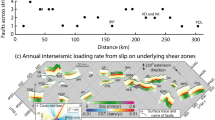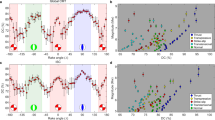Abstract
The laboratory tests carried out in studying shear and tensile seismogenic displacements occurring in compressed samples, led us to search for earthquakes with a tensile source component. To determine this component in the seismic focus, a special procedure based on the construction of radiation patterns of the combined shear-tensile type is introduced.
The criteria for selecting the events produced by the combined source mechanism are listed, and their limitations are mentioned. From the seismic zones with good azimuthal distribution of stations in the world seismic network nine earthquakes which occurred in the 6-year period 1976–1981 were analyzed; for these events better agreement of the observed and theoretical patterns was found for the combined shear-tensile source mechanism than for the pure double-couple mechanism. However, the share of the tensile component was always, found to be relatively small, ranging from 1 to 13 percent of the shear component. The comparison of the two solutions (double-couple vs. combined shear/tensile) is based on the first onset signs statistics.
The results obtained indicate that tensile fracturing does not play a substantial role in the total amount of released seismic energy; on the orther hand, it is expected to be more important in the creation and development of focal zone morphology from both the instantaneous and long-term point of view.
Similar content being viewed by others
References
Akasheh, B. andBerckhemer, H. (1970),Focal mechanism of deep and shallow earthquakes as derived from short and long period seismograms. Proc. X. Ass. ESC, Leningrad 1968, Acad. Sci. USSR, Vol. II, 334–359.
Aki, K. (1984),Evidence for magma intrusion during the Mammoth Lakes earthquakes of May 1980 and implications of the absence of volcanic (harmonic) tremor, J. Geophys.Res.89, 7689–7696.
Babuška, V. et al (1980),Physics of seismic wave fields and earthquake foci, InGeophysical Synthesis in Czechoslovakia (Veda, Bratislava, 1981).
Bombolakis, E. G. (1973),Study of the brittle fracture process under uniaxial compression. Tectonophysics18, 231–248.
Fitch, T. J., Cowan, D. W. andShields, M. W. (1980),Estimation of the seismic moment tensor from teleseismic body waves data with applications to interplate and mantle earthquakes. J. Geophys. Res.15, 3817–3828.
Foulger, G. R. andLong, R. E. (1985),Evidence for tensile crack earthquakes on an accelerating plate boundary. Proc. IASPEI, S7-37 (Tokyo, August 1985), p. 407.
Hart, R. (1978),Body wave studies of the September, 1969, north Atlantic Ridge earthquake (Abstract). EOS Trans. AGU59, 115.
Kanamori, H. (1985),Non-double couple seismic source. Proc. IASPEI, S7-56 (Tokyo, August 1985) p. 425.
Košťák, B., Kozák, J. andLokajíček, T. (1984/85),Contact conditions on seismoactive faults. PAGEOPH122, 680–693.
Kozák, J., Šílený, J. andWaniek, L. (1981),Fault plance induced tensile crack. Studia Geoph. et Geod.25, 332–342.
Kozák, J., Lokajíček, T., Pros, Z. andWaniek, L. (1982),Seismic signals generated by fault plane induced tensile cracks. Earthq. Pred. Res. 1,4, 331–337.
Kozák, J., Lokajíček, T. andŠílený, J. (1983),Propagation velocity and radiation properties of induced tensile cracks, Sudia Geoph. et Geod.27, 133–144.
Kozák, J., Šíleny, J. andŠpičák, A. (1984),Remarks on seismic energy release related to strike-slip and tensile crack mechanisms. Studia Geoph. et Geod.28, 156–163.
Kozák, J., andŠílený.,J. (1985),Seismic events with non-shear component: I. Shallow earthquakes with a possible tensile source component, PAGEOPH123, 1–15.
Lockner, D. andByerlee, J. (1977),Acoustic emission, and creep in rock at high confining pressure and differential stress. Bull. Seismol. Soc. Am.57, 247–258.
Lokajíček, T. andŠpičák, A. (1985),Classifying seismic regions according to the uniformity of the distribution of seismograph stations. Proc. 3rd Sump. on Seismicity and Seismic Risk, Liblice, Czechoslovakia, June 1985, pp. 248–255.
Nemath-Nasser, S. andHorii, H. (1982),Compression induced non-planar extension with application to splitting, explotion and rock burst. J. Geophys. Res.87, 6805–6822.
Ritsema, A. R. (1964),Some reliable fault plane solutions, PAGEOPH59, 58–74.
Ritsema, A. R. (1965),Problematics of small shallow earthquake mechanisms, Proc. VESIAC Conf., La Jolla, March (1965), 25–35.
Ritsema, A. R. andHoutgast, G. (1971),Seismicity of the North Atlantic, Obs. Roy. Belg. Ser. A 13, Geoph.,101, 99.
Robson, G. R., et al. (1968),Extension failure: an earthquake mechanism. Nature218, 28–32.
Shamina, O. G.,Modelnyie issledovanyia fiziki ochaga zemlyetrasenyi, in Russian, (Model investigations of the seismic source physics) (Nauka, Moscow 1981).
Shimizu, H., Ueki, S. andKoyama, J. (1985),Tensile-shear crack for a mechanism of volcanic earthquakes. Proc. IASPEI, S7-73, (Tokyo, August 1985) p. 442.
Solomon, S. C. andJulian, B. R. (1974),Seismic constraints on ocean-ridge mantle structure: anomalous fault plane solutions from first motions, J. Roy. Astron. Soc.38, 265–285.
Šílený, J. (1983),Source parameters for stick-slip and tensile crack mechanisms and possibilities of their seismic discrimination. Studia Geoph. et Geod.27, 143–156.
Tréhu, A. M., Nábělek, J. L., andSolomon, S. C. (1981),Source characterization of two Reykjanes Ridge earthquakes: surface waves and moment tensors; P waveforms and nonorthogonal nodal planes. J. Geophys. Res.86, 1701–1724.
Waniek, L. andVaněk, J. (1980),Radiation, pattern of P and Rayleigh waves for an experimental strike slip fault model. Studia. Geoph. et Geod.24, 218.
Author information
Authors and Affiliations
Rights and permissions
About this article
Cite this article
Šílený, J., Ritsema, A.R., Csikos, I. et al. Do some shallow earthquakes have a tensile source component?. PAGEOPH 124, 825–840 (1986). https://doi.org/10.1007/BF00879613
Received:
Accepted:
Issue Date:
DOI: https://doi.org/10.1007/BF00879613




